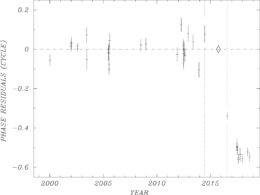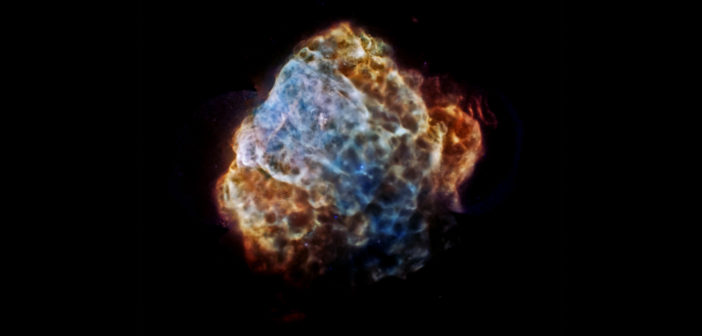Compact objects — the extremely dense remnants left behind after the death of massive stars — continually surprise us with their wide variety of properties and behaviors. Now one compact object known for its stability and predictability has thrown a further hitch into our understanding.
What’s Left Behind

Artist’s impression of the strong magnetic fields and beams of radiation emitted by a typical pulsar. [NASA]
One particularly puzzling type of body is something we — perhaps unoriginally — termed central compact objects, or CCOs. CCOs lie at the heart of supernova remnants, and they’re detected by their surface X-ray emission. Unlike typical pulsars, however, CCOs are not detectable in other wavelengths, and they do not have strong surface magnetic fields.

Pulse-phase residuals for pulsar 1E 1207.4–5209 reveal a glitch in its rotation at the end of September 2015. [Gotthelf & Halpern 2018]
An additional feature distinguishing CCOs from pulsars is their stable and slow spin-down rate. As spinning neutron stars age, they lose energy, spinning slower and slower. In typical pulsars, this steady spin-down can be interrupted by hiccups known as glitches, during which the spin frequency of the pulsar suddenly jumps back up — perhaps due to surface starquakes, or motions of the neutron-star interior.
CCOs, however, are very stable rotators that lose their energy more gradually than typical pulsars. Until now, no one has observed glitches in neutron stars that have spin-down rates as small as those measured in CCOs. But new observations of the CCO 1E 1207.4–5209, presented in a recent publication by Columbia Astrophysics Laboratory researchers Eric Gotthelf and Jules Halpern, have now changed this.
Buried Fields?
Using XMM-Newton and Chandra X-ray data, Gotthelf and Halpern identify a major glitch in 1E 1207.4–5209’s rotation that occurred at the end of September 2015. This unexpected hiccup provides further evidence of the relation between CCOs and more typical pulsars, and it lets us examine the mechanisms that may be at work in the evolution of spinning neutron stars.

Pre- and post-glitch spectra of pulsar 1E 1207.4–5209 from XMM-Newton show no significant change in line centroids — and therefore magnetic field strength — following the glitch. [Gotthelf & Halpern 2018]
Gotthelf and Halpern stress that we should continue to watch 1E 1207.4–5209 in the future, particularly to see if the glitch might have caused it the CCO to transition into a more typical radio-bright pulsar. In the meantime, we have a few more mysteries to puzzle over as we ponder these odd stellar remnants.
Citation
“The First Glitch in a Central Compact Object Pulsar: 1E 1207.4–5209,” E. V. Gotthelf and J. P. Halpern 2018 ApJ 866 154. doi:10.3847/1538-4357/aae152

2 Comments
Pingback: AAS Nova – New
Pingback: November 3 – November 9, 2018 | Colorado Space News